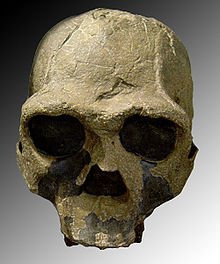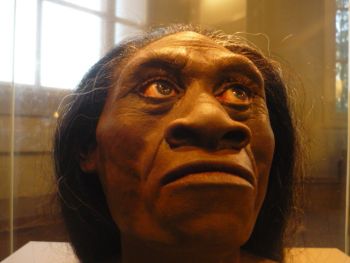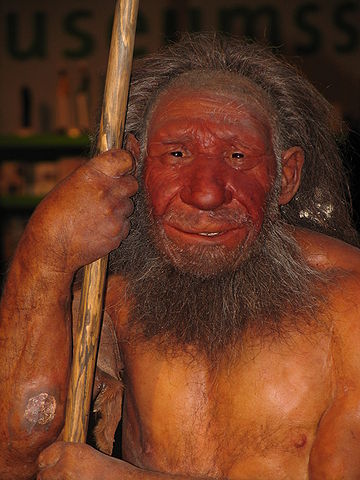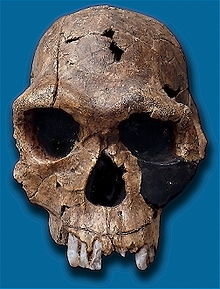Primates: Homo
Taxa on This Page
- Homo
- Homo erectus
- Homo floresiensis
- Homo habilis
- Homo heidelbergensis
- Homo neanderthalensis
- Homo sapiens
Descriptions
Homo Linnaeus 1758
Synonyms: Africanthropus Dreyer 1935, Atlanthropus Arambourg 1954, Cyphanthropus Pycraft 1928, Meganthropus, Paleoanthropus Kohl-Larsen & Reck 1936, Pithecanthropus Dubois 1894, Protanthropus Haeckel 1895, Sinanthropus Black 1927, Tchadanthropus Coppens 1965, Telanthropus Broom & Robinson 1949
Range: From the Late Pliocene, cosmopolitan
Phylogeny: Hominini : Ardipithecus + (Australopithecus afarensis + (Australopithecus africanus + (Paranthropus + (Kenyanthropus + * : Homo habilis + (Homo erectus + (Homo heidelbergensis + (Homo neanderthalensis + Homo sapiens)))))))
Comments: the most highly derived hominines, characterised by a spectacular increase in cranial capacity, from about 450 cc in Australopithecus garhi to 600 cc in Homo habilis, the most primitive species of the genus. Within the Homo genus, cranial capacity again doubled from H. habilis through Homo ergaster or H. erectus to Homo heidelbergensis by 0.6 million years ago. The cranial capacity of H. heidelbergensis overlaps with the range found in modern humans.
Although the advent of Homo was thought to coincide with the first evidence of stone tools (the Oldowan industry), and thus by definition with the beginning of the Lower Palaeolithic; however, recent evidence from Ethiopia now places the earliest evidence of stone tool usage at before 3.39 million years ago. The emergence of Homo coincides roughly with the onset of Quaternary glaciation, the beginning of the current ice age. - from Wikipedia
Homo habilis Leakey, Tobias & Napier 1964
Range: Late Pliocene of East Africa
Phylogeny: Homo : (Homo erectus + (Homo heidelbergensis + (Homo neanderthalensis + Homo sapiens))) + *
Comments: Homo habilis evolved in South and East Africa in the late Pliocene or early Pleistocene, when it diverged from the Australopithecines. Homo habilis had smaller molars and larger brains than the Australopithecines, and made tools from stone and perhaps animal bones. One of the first known hominids, it was nicknamed 'handy man' by discoverer Louis Leakey due to its association with stone tools. Some scientists have proposed moving this species out of Homo and into Australopithecus due to the morphology of its skeleton being more adapted to living on trees rather than to moving on two legs like Homo sapiens. It was considered to be the first species of the genus Homo until May 2010, when a new species, Homo gautengensis was discovered in South Africa, that most likely arose earlier than Homo habilis. adapted from Wikipedia - MAK120712
Image: Top: Replica of fossil skull of Homo habilis, found at Koobi Fora, Kenya. José-Manuel Benito Álvarez , Public domain, via Wikipedia.
Image: Bottom: life reconstruction of Homo habilis, photograph by Lillyundfreya, Creative Commons Attribution Share Alike, via Wikipedia

Homo erectus Dubois 1892
Synonyms: Anthropopithecus erectus, Pithecanthropus erectus; incl. Sinanthropus lantianensis Woo 1964, Homo leakeyi Clarke 1990 non Paterson 1940, H. erectus leakeyi, H. (Proanthropus) louisleakeyi Kretzoi 1984, Sinanthropus officinalis von Koenigswald 1953, H. erectus olduvaiensis Tobias 1968 (n. n.), S. pekinensis Black 1927, H. erectus pekinensis, H. (Javanthropus) soloensis Oppenoorth 1932, H. erectus soloensis]
Range: Early to Mid Pleistocene of Africa and Asia
Phylogeny: Homo : Homo habilis + ((Homo heidelbergensis + (Homo neanderthalensis + Homo sapiens)) + * ::: Homo floresiensis)
Comments: The first fossils of Homo erectus were discovered by Dutch physician Eugene Dubois in 1891 on the Indonesian island of Java. He originally named the material Pithecanthropus erectus based on its morphology, which he considered to be intermediate between that of humans and apes. An Early Pleistocene form, Homo ergaster, is considered to be a separate species, or it is seen as a subspecies of Homo erectus, Homo erectus ergaster.
Differs from Homo habilis in having larger brains and construction of more elaborate stone tools. Other new developments include the evolution of locking knees and a different location of the foramen magnum (the hole in the skull where the spine enters). At least some had developed the use of fire. Homo erectus bears a striking resemblance to modern humans, but had a brain about 74 percent of the size of modern man. Its forehead is less sloping and the teeth are smaller.
Other hominid designations such as Homo georgicus, Homo ergaster, Homo pekinensis, and Homo heidelbergensis are often put under the umbrella species name of Homo erectus, although recently there is the tendency to spearte them into disntinct species again, although this seems to be an example of the sort of oversplitting that characterises paleoanthropological taxonomy, as the degree of vararion is very small. Starting with Homo georgicus found in what is now the Republic of Georgia dated at 1.8 Ma, the pelvis and backbone grew more human-like and gave H. georgicus the ability to cover very long distances in order to follow herds of other animals. This is the oldest fossil of a hominid found (so far) outside of Africa. Control of fire by early humans is achieved 1.5 Ma by Homo ergaster. Homo ergaster reaches a height of around 1.9 metres. Evolution of dark skin, which is linked to the loss of body hair in human ancestors, is complete by 1.2 Ma. A famous example of Homo erectus is Peking Man, Homo pekinensis first appears in Asia around 700 Ka but according to the theory of a recent African origin of modern humans, they could not be human ancestors. Many paleoanthropologists now use the term Homo ergaster for the non-Asian forms of this group, and reserve Homo erectus only for those fossils that are found in Asia and meet certain skeletal and dental requirements which differ slightly from H. ergaster. - Adapted from Wikipedia - MAK120712
Image: Replica of fossil skull of Homo ergaster (African Homo erectus) discovered in 1975 in Kenya. Creative Commons Attribution Share Alike, GNU Free Documentation, via Wikipedia

Homo floresiensis Brown et al., 2004 : Hobbits
Range: Late Pleistocene of Flores, Indonesia
Phylogeny: Homo erectus ::: *
Comments: an H. erectus like form which lived from approximately 100,000 to 12,000 before present, has been nicknamed hobbit for its small size, which would seme to be the result of island dwarfism (a similar thing happened to Pleistocene elephants and Cretaceous dinosaurs).The main find was a skeleton believed to be a woman of about 30 years of age. Found in 2003 it has been dated to approximately 18,000 years old, and was only about a meter in height. Claims of pathological dwarfism and microcephaly are not accepted by the majority of paleonthropolgists, fail to explain how a population could survive in a harsh paleolithic environment, or the presence of archaic anatomical features of the skull, wrist, forearm, shoulder, knees, and feet. - from Wikipedia - MAK120712
Image: Reconstruction of the female's head of an Homo floresiensis. The picture was taken at the Natural History Museum in Washington DC, Photo by Donmatas, Creative Commons Attribution Share Alike, via Wikipedia

Homo heidelbergensis Schoetensack 1908
Range: Late Pleistocene of Europe and Africa
Phylogeny: Homo : Homo habilis + (Homo erectus + ((Homo neanderthalensis + Homo sapiens) + *))
Comments: originally used only to refer to "Heidelberg Man", now used to refer to hominines intermediate between H. erectus and H. sapiens and H. neanderthalensis, and that lived from about 800,000 to about 300,000 years ago. is morphologically very similar to Homo erectus but had a larger brain-case, about 93% the size of that of Homo sapiens. The holotype of the species was tall, 1.8 m and more muscular than modern humans. This very large hominine that had a more advanced complement of cutting tools and may have hunted big game. H. rhodesiensis (Rhodesian Man ), estimated to be 300,000–125,000 years old, has previously been considered a distinct species is now generally placed within the group of Homo heidelbergensis, though other designations such as Archaic Homo sapiens and Homo sapiens rhodesiensis have been proposed.
H. antecessor, known from fossils from Spain and England that are dated 1.2 million years ago, and H. cepranensis, known from a single skull cap from Italy, estimated to be about 800,000 years old. may be intermediate between H. erectus and H. heidelbergensis. Adapted from Wikipedia - MAK120712
Image: Homo heidelbergensis. Photo by Jose Luis Martinez Alvarez. Wikipedia, Creative Commons Attribution Share Alike

Homo neanderthalensis King 1864 Neanderthals
Synonyms: Homo sapiens neanderthalensis; incl. H. breladensis Marett 1911, H. calpicus Keith 1911, H. primigenius Schaaffhausen 1880, H. transprimigenius Forrer 1908]
Range: Late Pleistocene of Europe and West Asia
Phylogeny: Homo : Homo habilis + (Homo erectus + (Homo heidelbergensis + (Homo sapiens + *)))
Comments: Sterotyped as a stooped knuckle-dragger (on the basis of an arthritic skelton and social sterotypes), Neanderthals actaually had larger brains than modern humans. Co-existed with Homo sapiens in Europe for over 10,000 years. In 2010 sequencing of the Neanderthal genome showed that, contrary to earlier molecular sequencing, Neanderthals did indeed interbreed with anatomically modern humans circa 45,000 to 80,000 years ago (at the approximate time that modern humans migrated out from Africa, but before they dispersed into Europe, Asia and elsewhere). Competition from Homo sapiens probably contributed to Neanderthal extinction. - Wikipedia MAK120712
Links: The original Neanderthal skeleton from the Neander Valley, Wikipedia, Neanderthal Museum
Image: Reconstruction of a Neanderthal child from Gibraltar (Anthropological Institute, University of Zürich), copied from here
Homo sapiens Linnaeus 1758 Anatomically modern humans
Synonyms: Homo H. aethiopicus Bory de St. Vincent 1825, H. sapiens afer Linnaeus 1758, Telanthropus capensis Broom & Robinson 1949, H. erectus capensis, H. sapiens capensis, H. (Africanthropus) helmei Dreyer 1935, H. leakeyi Paterson 1940, H. spelaeus Lapouge 1899, Tchadanthropus uxoris Coppens 1965
Range: From the Late Pleistocene of Africa, Europe, Asia, and Austraia, Ubiqutious in the Holocene
Phylogeny: Homo : Homo habilis + (Homo erectus + (Homo heidelbergensis + (Homo neanderthalensis + * ::: Posthumanity?)))
Comments: anatomically modern humans. According to genetic studies, modern humans bred with "at least two groups" of ancient humans: Neanderthals and Denisovans. Current research has established that humans are genetically highly homogenous; that is, the DNA of individuals is more alike than usual for most species, which may have resulted from their relatively recent evolution or the possibility of a population bottleneck resulting from cataclysmic natural events such as the Toba catastrophe. Distinctive genetic characteristics have arisen, however, primarily as the result of small groups of people moving into new environmental circumstances. These adapted traits are a very small component of the Homo sapiens genome, but include various characteristics such as skin color and nose form, in addition to internal characteristics such as the ability to breathe more efficiently at high altitudes. H. sapiens idaltu, from Ethiopia, is an extinct sub-species from about 160,000 years ago. Humans repeatedly left Africa to populate Eurasia and finally the Americas, Oceania, and the rest of the world - adapted from Wikipedia By the start of the Holocene, Homo sapiens had become the most successful, ubiquitous, and abundant primate and indeed higher animal, and by historical and through to modern times has shaped the planet in unprecedented ways, creating on the one hand cultural diversity of astonishing richness and technology of astonishing complexity, yet on the other bringing about a major (and on -going) mass extinction that will be one of the most serious the planet has seen. Perhaps will evolve into Posthumanity? MAK120712




